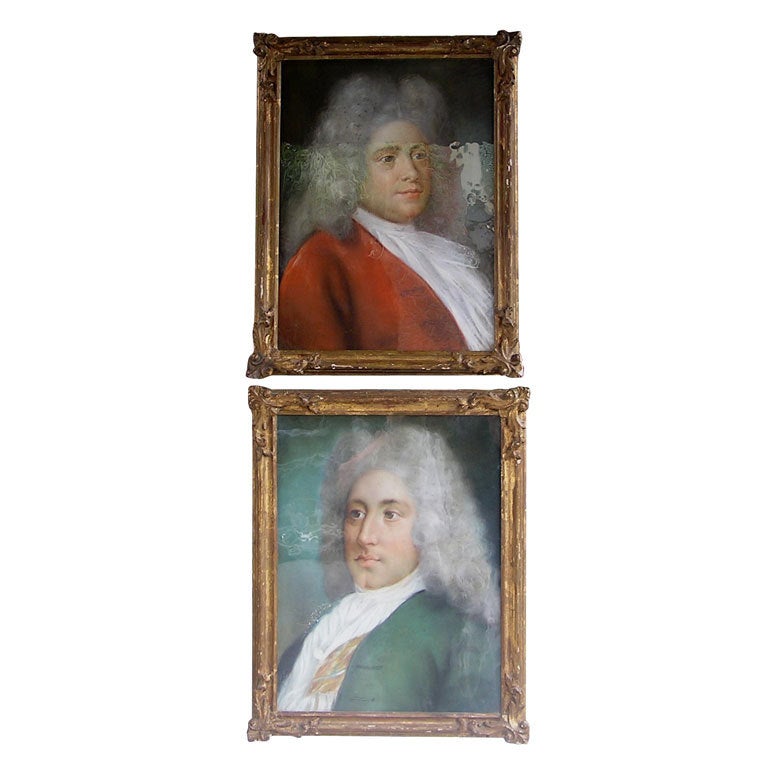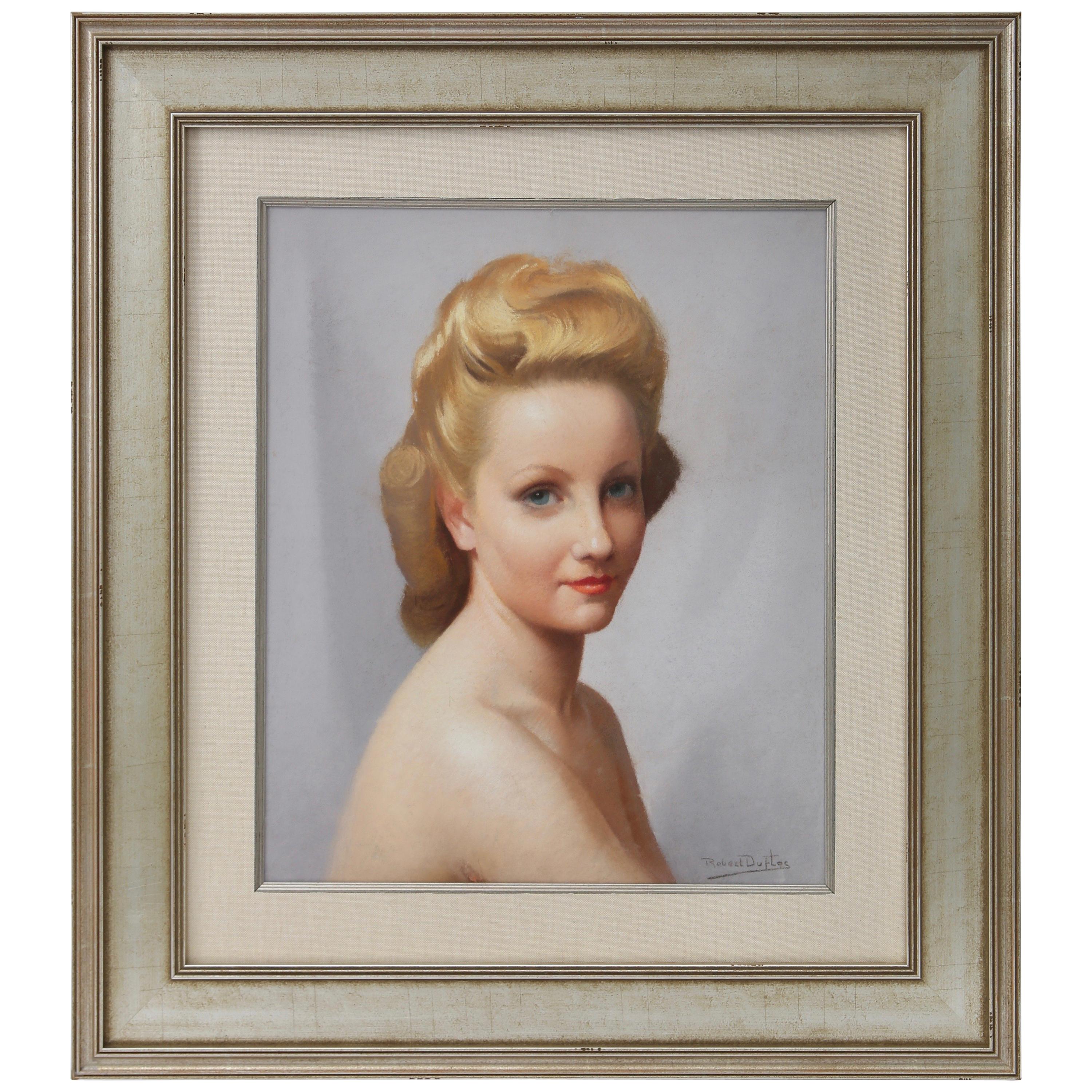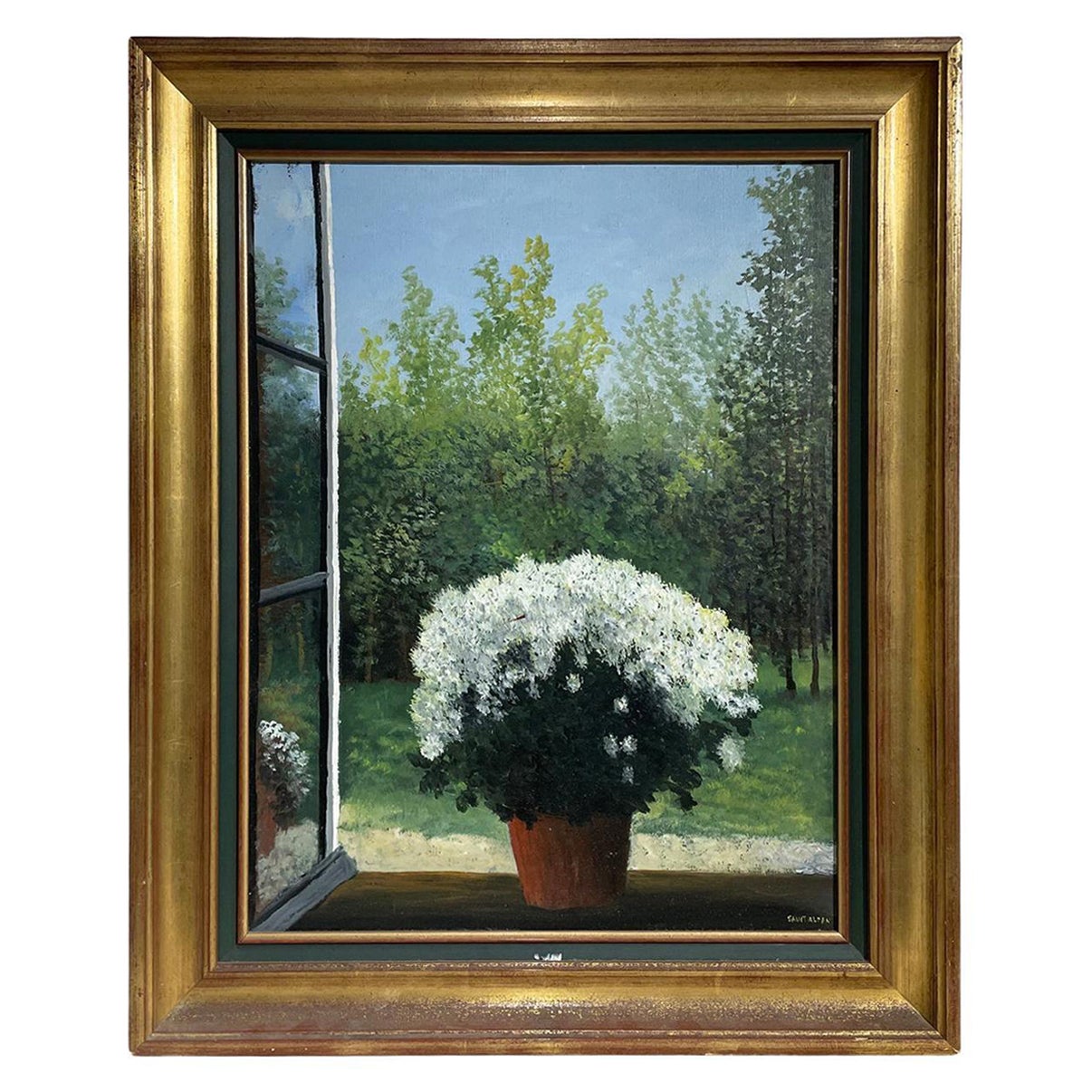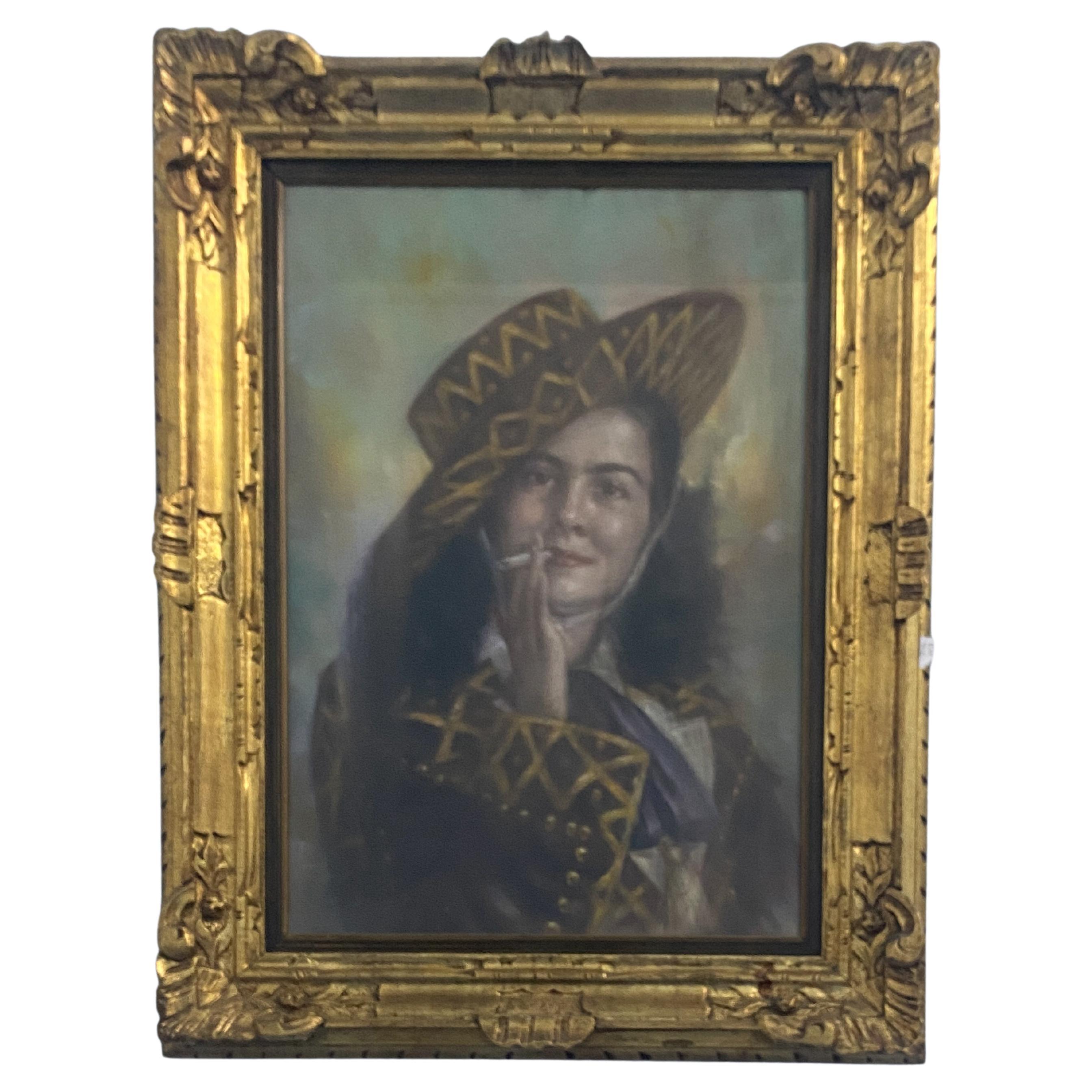Items Similar to Pair of Italian Rococo Pastels on Silk Portraits by Joseph De Saint Michel, 1769
Video Loading
Want more images or videos?
Request additional images or videos from the seller
1 of 21
Pair of Italian Rococo Pastels on Silk Portraits by Joseph De Saint Michel, 1769
About the Item
Joseph Comte de Saint Michel
(Turin, news between 1756 and 1790;
between 1756 and 1776 active at the court of the King of Sardinia in Turin)
Portrait of a Gentleman - Portrait of a Lady
Pastels on silk; coeval and original frames and glasses
Turin or Toulouse 1769
Both signed and dated “de St Michel 1769”
Each measure 19.29 x 14.96 in (49 x 38 cm)
with frame 28.34 x 19.68 in (72 x 50 cm)
lb 15.43 (kg 7)
Weight 13.22 lb (6 kg)
State of conservation: some additions to the painting.
The first portrait depicts a gentleman in a red velvet jacket trimmed with gold embroidery and decorated with the double honor of the order of San Gennaro and that of Santiago; the second, on the other hand, is a young lady in a pink silk brocade dress and fur appliques. The man regards the spectator absently, hinting at a benevolent smile suited to the circumstance, while the lady smiles primly with a relaxed mien. Some physiognomic details suggest that the painter was accustomed to portraiture and the signature affixed to both paintings confirms their authorship: both are signed and dated "de St Michel 1769".
The cream and gold frames are original, as are the glasses.
The information we have about the painter is scarce and fragmentary: Giuseppe Saint Michel was active from 1756-1790, known as “Knight” or “Count de Saint-Michel”, the painter of the King of Sardinia (Carlo Emanuele III of Savoia). He appears for the first time in Turin in 1756, when a documented payment was made by the royal house for a portrait of Giuseppina di Savoia (the future Countess of Provence) along with her nurse.
The works certainly ascribable to his hand and known to this date are portraits that he almost always had the tendency to sign and date: this habit of his, together with the news he himself provided in the promotional announcements he published, gives us a detailed picture of his shifts through all the courts of Europe as an itinerant portrait painter.
A study of his works prior to 1764 revealed the influence of the French pastellist Alexis Grimou (Argenteuil, 1678 - Paris, 1733) and a technique still to be perfected. Saint-Michel worked in a very small format, perhaps for the convenience of his itinerant practice, but the results, with homogeneous poses, marked folds of fabric and a typical palette of southern heat, are easily recognizable even without his signature.
In the various works there is a considerable variation in the quality of the execution. Some of the smaller examples show the intensity of a technical miniaturist; the male portraits are generally more naturalistic than the female ones, which sometimes exhibit forced poses. The folds and the yield in the fabrics are also characteristic, as Ratouis de Limay (Ratouis de Limay, Le Pastel en France au XVIIIe siècle, Paris, éd. Baudinière, 1946) tells us when analyzing one of his works preserved in the Gunnar Lundberg collection.
The oldest portrait known so far is that of Mme de L’Espi and dates back to 1761.
In 1769, according to the autograph inscriptions placed on our pastels, the painter was already defined as "le comte de St Michel".
We are aware of the fact that two of his landscape watercolors were exhibited at the Salon de Toulouse in 1768. The news is taken from a long note in Avant-Coureur of 29.VIII.1768 (p. 547f) in which the painter is defined as follows: “M. de Saint-Michel, gentilhomme piémontais, residing in Toulouse, known for a large number of portraits "of great resemblance to the truth" and for his pastel technique "such as to give the figures the depth of the oil technique"”.
In this period he, in order to allow everyone to benefit from his technique, tried to publish a work in which he explained a method of pastel painting with the title “Abrégé de la Peinture”. The technical tests would have been carried out in the presence of several members of the Parliament of Capitoulate and of the Academy of Painting in Toulouse, called by de Saint-Michel as judges of their own experiments. The text, available only by subscription, would have been published upon reaching an adequate number of bookings. Unfortunately, since no such publication has ever come down to us, it can be deduced that the required number of subscribers was not reached.
Two years later, several pastel portraits belonging to the Marquis de Mirepoix confirm the presence of the painter in France, while in 1771 he was certainly in Orleans. From the Annonces, affiches, nouvelles et avis divers de l'Orléanais of 22.XI.1771, we know in fact that “M. de St. Michel, Painter of the King of Sardinia, who alone found the secret of fixing the crayon in such a way as to last forever, he arrived in Orleans, where he intended to do only a short stay and then to go to Paris [...] "
In 1772 he resided in Paris, where he was likely to have painted the imposing pastel of the Sardinian ambassador Ferrero della Marmora. He again boasted of having invented, - but perhaps he only used one of the inventions of the Prince of Sansevero - a method for fixing pastels, which he submitted to the Academy for approval on 7.VI.1772. The report by Bachelier and Roslin, regarding this fact, was not published. However, in a note that appeared in the Journal encyclopédique in.IX.1772, pp. 476-78, under the title “Arts utiles & agréables” and in other newspapers, the same painter announced the beauty of the pastel technique and the fact that he managed to make it endure through time: "M. de Saint-Michel, Piedmontese gentleman, painter of the King of Sardinia, and of the Bishop Prince and Princess of Carignano, found the secret to making pastel images solid, resistant as the oil technique and able to be retouched by the painter even after being fixed. The images have nothing to fear, nor the jolts of the carriages on longer journeys, nor the friction nor the temperature of the seasons. He also invented the composition of a pastel superior to all that is known in this technique, of a very pleasant delicacy and in all colors; presented both the discoveries and the tests at the “Académie royale de peinture et de sculpture” in Paris, which issued him with a very favorable certificate [...] ".
Giuseppe di St. Michel therefore, to contribute to the progress of the arts, tried again to share his discovery with the public, and tried again to publish his secrets by subscription: the validity of the technique was evidenced by the certificate of the Parisian Academy dated 7 August 1772. Several years later, in a note by a contemporary author, Paul-Romain Chaperon in the Traité de la peinture au pastel of 1788, we learn of a negative judgment concerning the Saint-Michel subscription project.
From a portrait dated 1773 we deduce that the painter must have been in St. Petersburg: the portrait is that of the Austrian ambassador, Fürst Lobkowicz, whose weekly reports in Kaunitz show that he was in service in the Russian city during that year.
Nothing is known about the movements of Saint-Michel in the following years: he must have transited from Metz to Lorraine, where he offered private lessons in the “Affiches, annonces et avis divers pour les Trois Evêchés et la Lorraine for .VI.1777”; then in Caen in the same year, where he made an unusual pastel portrait of the wife of the Count of Perrochel, “capitaine de dragons dans le régiment de Monsieur”.
Saint-Michel later arrived in London, where he exhibited six portraits - of which we have no details - at the Royal Academy in 1785. The only surviving crayon which we know of from this journey is "inscribed in florid calligraphy and uncertain English" (Joshua James FOSTER, ed., “French art from Watteau to Prudhon”, London, 1905-07).
After this stay in London there were no more signs for five years until, in 1790, Giuseppe de Saint Michel painted a portrait of a two-year-old boy in Liège.
We have no more news after this portrait.
Bibliography
Alessandro, Count BAUDI DI VESME, Schede Vesme: Art in Piedmont from the 16th to the 18th century, Turin, 1963-68, p. 961; Bénézit; Busch 1817, p. 101, which cites the Supplem. zu Vollbedings Archiv. 200 & 201; Jean CHATELUS, Peindre à Paris au XVIIIe siècle, Nîmes, 1991, p. 73; Ulrich Thieme & Felix Becker, Allgemeines Lexikon der bildenden Künstler, 1929; Gérard VOREAUX, Les Peintres lorrains du dix-huitième siècle, Paris, 1998; Waterhouse, The Dictionary of British 18th century painters in oils and crayons, Woodbridge, 1981.
- Creator:Joseph de Saint-Michel (Painter)
- Dimensions:Height: 28.35 in (72 cm)Width: 19.69 in (50 cm)Depth: 2.37 in (6 cm)
- Sold As:Set of 2
- Style:Rococo (Of the Period)
- Materials and Techniques:
- Place of Origin:
- Period:1760-1769
- Date of Manufacture:1769
- Condition:Minor losses. Minor fading. Some additions to the painting.
- Seller Location:Milano, IT
- Reference Number:1stDibs: LU4352216341362
About the Seller
4.3
Vetted Seller
These experienced sellers undergo a comprehensive evaluation by our team of in-house experts.
Established in 1860
1stDibs seller since 2018
19 sales on 1stDibs
Typical response time: 6 hours
Associations
International Confederation of Art and Antique Dealers' Associations
- ShippingRetrieving quote...Ships From: Milano, Italy
- Return PolicyA return for this item may be initiated within 14 days of delivery.
More From This SellerView All
- Rococo Italian Bureau-Cabinet, Milan, circa 1760Located in Milano, ITBureau-cabinet with fold-down writing desk Lombardy, third quarter of the 18th century Walnut with carved decoration and walnut-burl veneer; applied ebonized wood trim and cornice ...Category
Antique 1750s Italian Rococo Cabinets
MaterialsWalnut
- Rococo Italian Maiolica Flower Pot Pasquale Rubati, Milano, 1770 circaBy Pasquale RubatiLocated in Milano, ITMaiolica flower pot “a mezzaluna” with support feet decorated with little bunches of flowers Pasquale Rubati Factory Milan, circa 1770 5.5 in X ...Category
Antique 1770s Italian Rococo Ceramics
MaterialsMaiolica
- Ancient Pair of Italian Maiolica Dishes Milano, circa 1770By Felice ClericiLocated in Milano, ITTwo maiolica dishes, "Famille Rose" decoration Felice Clerici Factory Milan, 1770-1780 9.13 in (23.2 cm) each in diameter lb 1.32 (kg 0.6) State of conservation: perfect, except for...Category
Antique 1770s Italian Rococo Ceramics
MaterialsMaiolica
- Pair of Italian Maiolica Tureens, Ferretti Manufacture, Lodi Circa 1770 - 1780By Antonio FerrettiLocated in Milano, ITPair of maiolica tureens Antonio Ferretti Manufacture Lodi, circa 1770-1780 Maiolica polychrome decorated “a piccolo fuoco” (third fire). a – 8.66 x 11.02 x 7.48 in (22 x 28 x 19...Category
Antique 1770s Italian Rococo Ceramics
MaterialsMaiolica
- Ancient Italian Pair of Armchairs in “Petit Point” Embroidery, Turin Circa 1750Located in Milano, ITPair of carved walnut armchairs covered in “petit point” embroidery Turin, circa 1750 They measure 33.8 in (86 cm) in height; 17.32 in (44 cm) in height to the seat; 25.98 in (66 cm...Category
Antique Mid-18th Century Italian Rococo Armchairs
MaterialsWool, Walnut
- Pair of Ancient Italian Maiolica Flower Pots Milan, Rubati Factory, 1770 circaBy Pasquale RubatiLocated in Milano, ITMaiolica flower pot “a mezzaluna” decorated with trompe l’oeil Pasquale Rubati Factory Milan, circa 1770 Measures: each 4.7 in (cm 12) x 5 in (c...Category
Antique 1770s Italian Rococo Ceramics
MaterialsMaiolica
You May Also Like
- Pair of Austrian Pastel PortraitsLocated in Hollywood, SCPair of Austrian pastel portraits of country gentlemen in original carved wood gilt frames. Portraits retain the original glass.Category
Antique 18th Century and Earlier Austrian Paintings
- Pastel Portrait of a WomanBy Robert Louis Raymond DuflosLocated in West Palm Beach, FLThis beautiful pastel three-quarter-pose portrait was recently acquired from a London, England estate and it dates to the late 1920s to the early 1940s. The artist Robert Louis Raymo...Category
Early 20th Century French Art Deco Paintings
MaterialsPaper
- Antique Italian pastel painting "Portrait of a Woman" Italy , signed, 1963Located in Traversetolo, ITStunning pastel painting " Portrait of a Woman" signed, executed in Italy in 1963, the author demonstrates good skill in portraying the female figure ,the details of the dress are ex...Category
Vintage 1960s Italian Mid-Century Modern Paintings
MaterialsCanvas, Wood, Crayon
- 20th Century French Still Life Oil on Canvas Painting by Michel De Saint-AlbanBy Michel De Saint-AlbanLocated in West Palm Beach, FLA white-green, vintage French still life oil on canvas painting by Michel De Saint-Alban in a hand crafted, original gilded wood frame, i...Category
Mid-20th Century French Mid-Century Modern Decorative Art
MaterialsCanvas, Giltwood
- Portrait of D. Maria Bárbara De Bragança, Circle of Louis-Michel Van LooBy H. van LoonLocated in Lisboa, PTPORTRAIT OF D. MARIA BÁRBARA DE BRAGANÇA (1711-1758), QUEEN OF SPAIN Circle of Louis-Michel van Loo (1707-1771) Oil on canvas Her Royal Highness, the Infanta Maria Barbara of Braganza (1711-1758) was the first-born child of King John V of Portugal (1689-1750) and his queen consort Maria Anna of Austria (1683-1754). Born in December 1711, she had the Convent Palace of Mafra built in her honour following a vow made by her royal father. Her status as Princess of Brazil, inherent to 18th century Portuguese presumptive heirs, would however be superseded once the queen gave birth to two male princes, D. Pedro (1712-1714) and D. José (1714-1777), preventing her from ascending to the throne. Daughter of one of the most illustrious monarchs of his time, Maria Barbara was carefully educated to become a fond admirer of the arts, and of music in particular, having had the Italian composer Domenico Scarlatti (1685-1757) as her music teacher. On the 10th January 1723 the young princess was betrothed to the Infante Ferdinand of Spain (1713-1759), eldest son of King Philip V (1683-1746). Six years later, on the 19th January, she entered her new country in a carefully choreographed ceremony that became known to history as the “Exchange of the Princesses”. This unique event took place on a specially built Bridge-Palace, a wooden, luxuriously decorated structure that included various modules and rooms, on both banks of the river Caia, the natural border between the town of Elvas in Portugal and of Badajoz in Spain. Simultaneously, on the same day that the Portuguese Infanta crossed the border to marry the Spanish Crown Prince, her new sister in law, the Infanta Mariana Victoria of Bourbon (1718-1781), her husband’s sister, crossed the same bridge in the opposite direction to marry Prince D. José, the Portuguese heir to the throne. Once married, Maria Barbara would spend 17 years as Princess of Asturias, only becoming Queen of Spain at her husband’s accession following the death of Philip V in 1746. She is portrayed in the 1743 painting by Louis-Michel van Loo (1707-1771) now in the Prado Museum, in which Philip V had himself represented with all his close family. The new Queen would take an important role at court eventually becoming the liaison between her husband and the King of Portugal, particularly throughout the negotiations for the Treaty of Madrid (1746-1750). Maintaining her interest in music, she patronized the Italian castrato singer Farinelli (1705-1782) while remaining close to her old master Scarlatti, having herself composed some sonatas for a large orchestra. She would also commission and fund the building of the Royal Salesians Monastery complex in central Madrid, where both her and Ferdinand VI are buried. The portrait we are presenting for sale shows the Queen in half-length, turning left at three quarters. She is wearing a blue low-cut dress embroidered with flowers and foliage, over a lace cuffed white blouse, and an ermine cloak pined on the left-hand side by a diamond broach. The powdered hair style is held sideways by a seven diamond and black plume headdress and topped by a small gold and pearl crown. The right arm rests on a cushion while the left hand, at chest height, holds a miniature male portrait. The Infanta’s features are analogous to the 1725 portrait by the painter Domenico Duprà (1689-1770), also in the Prado Museum collection. Further similarities can be found in another portrait by Louis-Michel van Loo, in which a seven diamond and black plume headdress is also present. In this work, the cushion supporting Maria Barbara’s right arm has also some obvious similarities to our painting. The same diamond headdress reappears in Van Loo’s above-mentioned portrait of Philip V’s family dated from 1743. It is nevertheless in Lisbon’s Ajuda National Palace that it is possible to find an almost identical depiction of the Infanta holding a miniature portrait of her husband. In it, the future Ferdinand VI is portrayed facing right at three quarters and wearing a curly wig, suit of armour, the golden fleece insignia and a blue band, in a composition that closely resembles an 18th century Spanish school painting that appeared in the art market in January 2016. Another detail common to various portraits of the Portuguese Infanta and Queen of Spain is the small gold and pearl crown on her head. In another Van Loo painting, also from the Prado Museum, in which Maria Barbara is portrayed as Queen, this crown is represented together with a headdress similar to the one previously described. Another two paintings by the same artist, at the Royal Academy of Saint Ferdinand, include the same ornament. We must also refer the paintings by the artist Jean Ranc (1674-1735). In one, dating from 1729 (Prado Museum), the Infanta is depicted outdoors holding a flower bouquet and wearing a yellow silk dress with red cloak, and a set of diamond and ruby jewellery that includes a headdress similar to the one present in our portrait. Another work by the same artist, belonging to the Complutence University of Madrid, depicts the Infanta sumptuously dressed in identical colours to our painting and wearing an elaborate headdress and diadem. These portraits, beyond their iconographical importance as contemporary records of the Infanta and Queen Maria Barbara, are also illustrative of 18th century fashion for jewelled head dressing. Often, flowers were combined with joyful adornments, composing almost theatrical displays that would reinforce the ostentatious nature of the image. The ornamental flowers and the chromatic character of the jewels would complement the luxury of the colourful dresses in blue, crimson, green or other silk shades, in compositions whose sole purpose was to highlight a royal sitter’s wealth and power, becoming an essential statement accessory within the strict court protocols and codes of conduct. Circle of Louis-Michel van Loo (1707-1771) Slowly but steadily, the resolute, tranquil and dignified attitude of Renaissance and Baroque portraiture becomes artificial and presumptuous. Mid 18th century society favours elusive expression and psychological deepness, albeit limited to the face, that, with emphasis on detail, on the rich colour palette and on changing costumes and landscapes, associated to the courtliness of gestures, creates a strongly artificial environment while maintaining a highly poetic intrinsic character. Louis-Michel van Loo followed a dynasty of famous Dutch origin artists that had settled in France. Initially taught by his father, Jean-Baptiste von Loo (1684-1745), the younger van Loo studied in Turin and Rome and frequented the Paris Academy. In Rome he worked with his uncle Charles-André van Loo (1705-1765) and become a painter for the Turin Court. In 1737 he arrived in Spain being summoned by Philip V to succeed Jean Ranc as painter of the king’s chamber. In Madrid, his work covers the numerous Court commissions and the Royal Saint Ferdinand Fine Arts Academy, of which he was a founding member and director for the Painting department in 1752. Is production at court consisted essentially of numerous portrait paintings, often Royal gifts...Category
Antique 18th Century Spanish Baroque Paintings
MaterialsCanvas
- Pretty Portrait of Young Woman, Old Pastel on CardboardBy Michel JarryLocated in Alessandria, PiemonteCute Portrait of a young woman with chignon, pastel on cardboard. Why not create a gallery of smiling female portraits ? An Italian client of mine...Category
Antique 1880s French Early Victorian Paintings
MaterialsPaper
Recently Viewed
View AllMore Ways To Browse
Italian Saint
Pair Saints
Payment Methods
Foldable Wall Wood
Calligraphy Wall
Pair Of European Paintings
Pair Of Carved Gold Frames
French Pair Portraits
Rococo Pink
Learn Antique Furniture
Pair Of Small Framed Painting
Italian Embroidery Fabric
King Rococo
Russian Wall Sculptures
Hand Carved Rococo Frames
Piedmont Furniture
Hand Embroidery Italian
Italian Male Paintings




